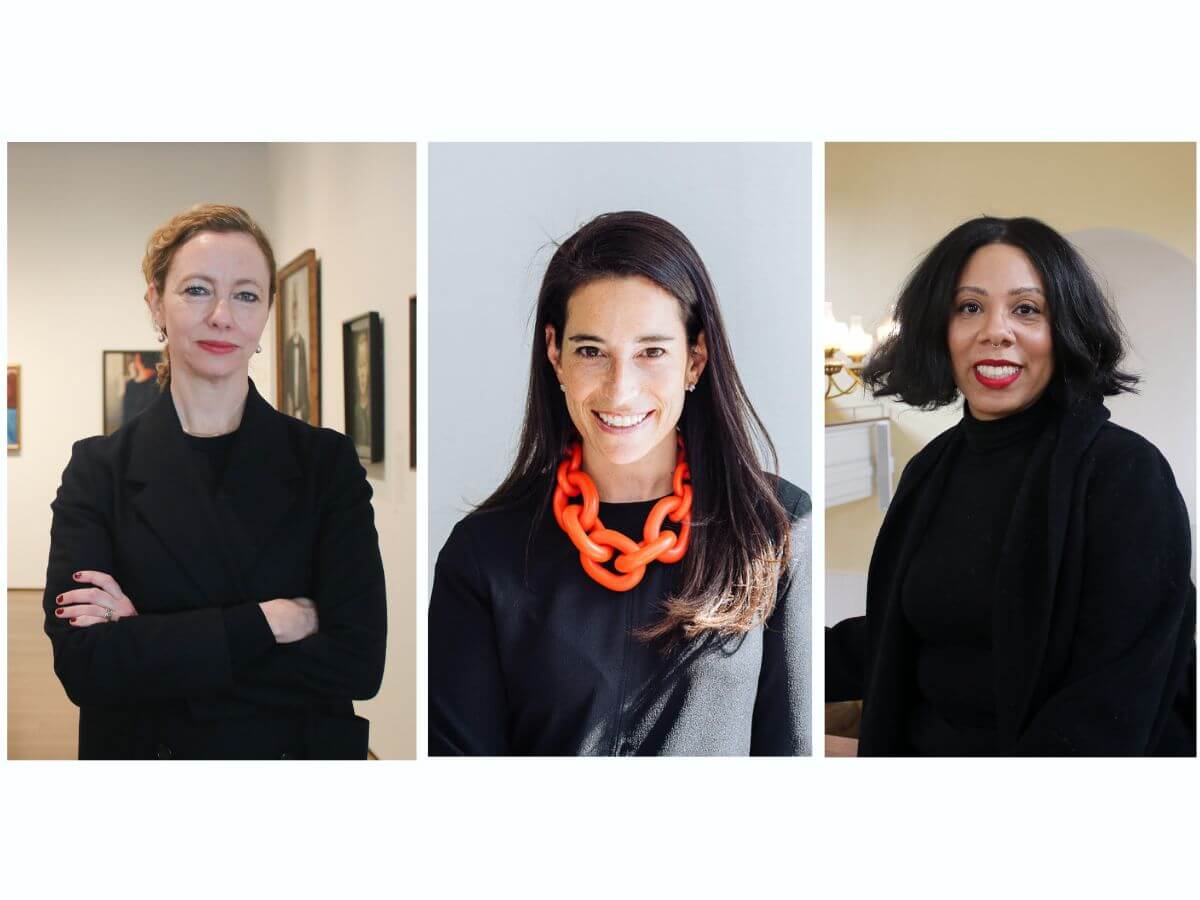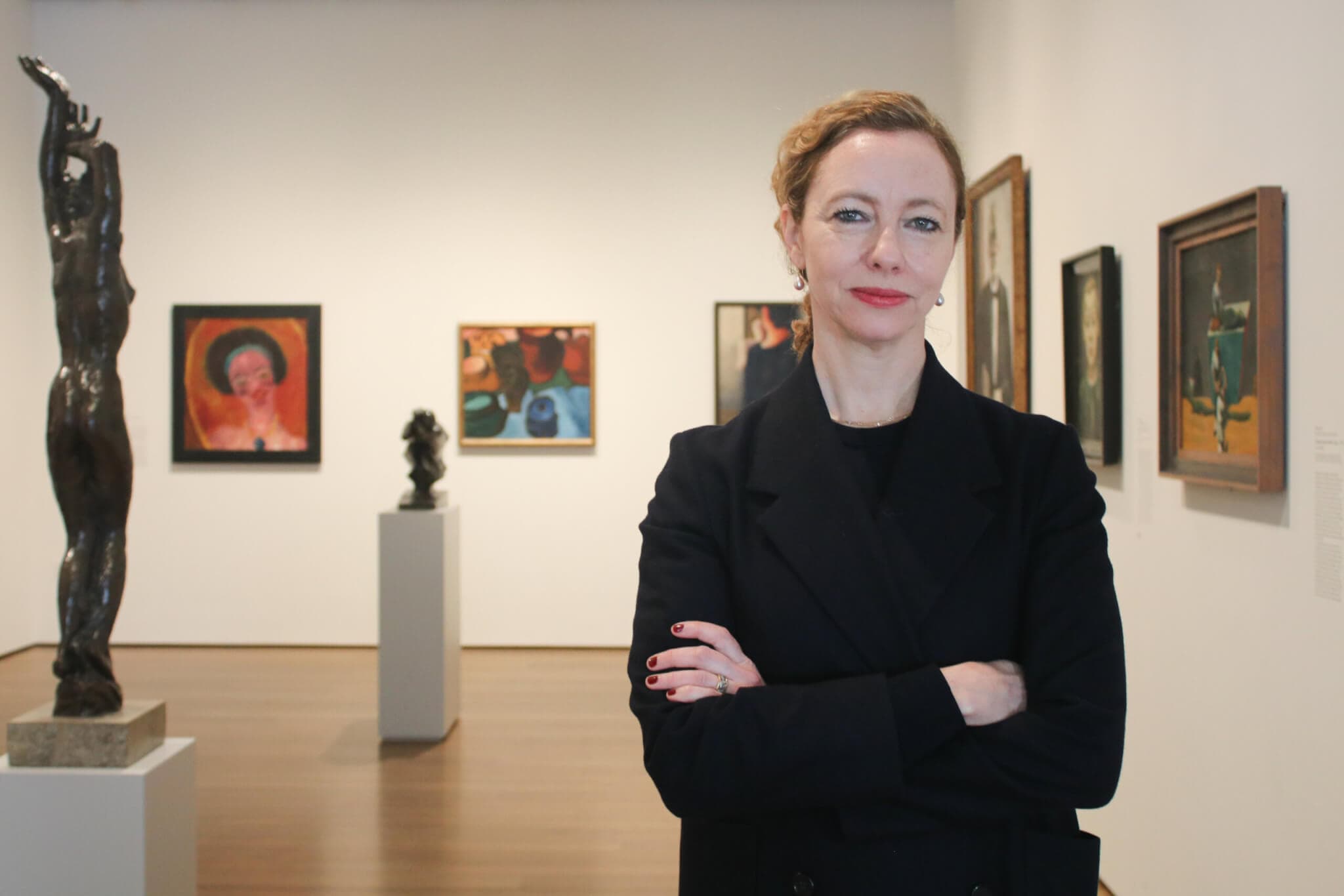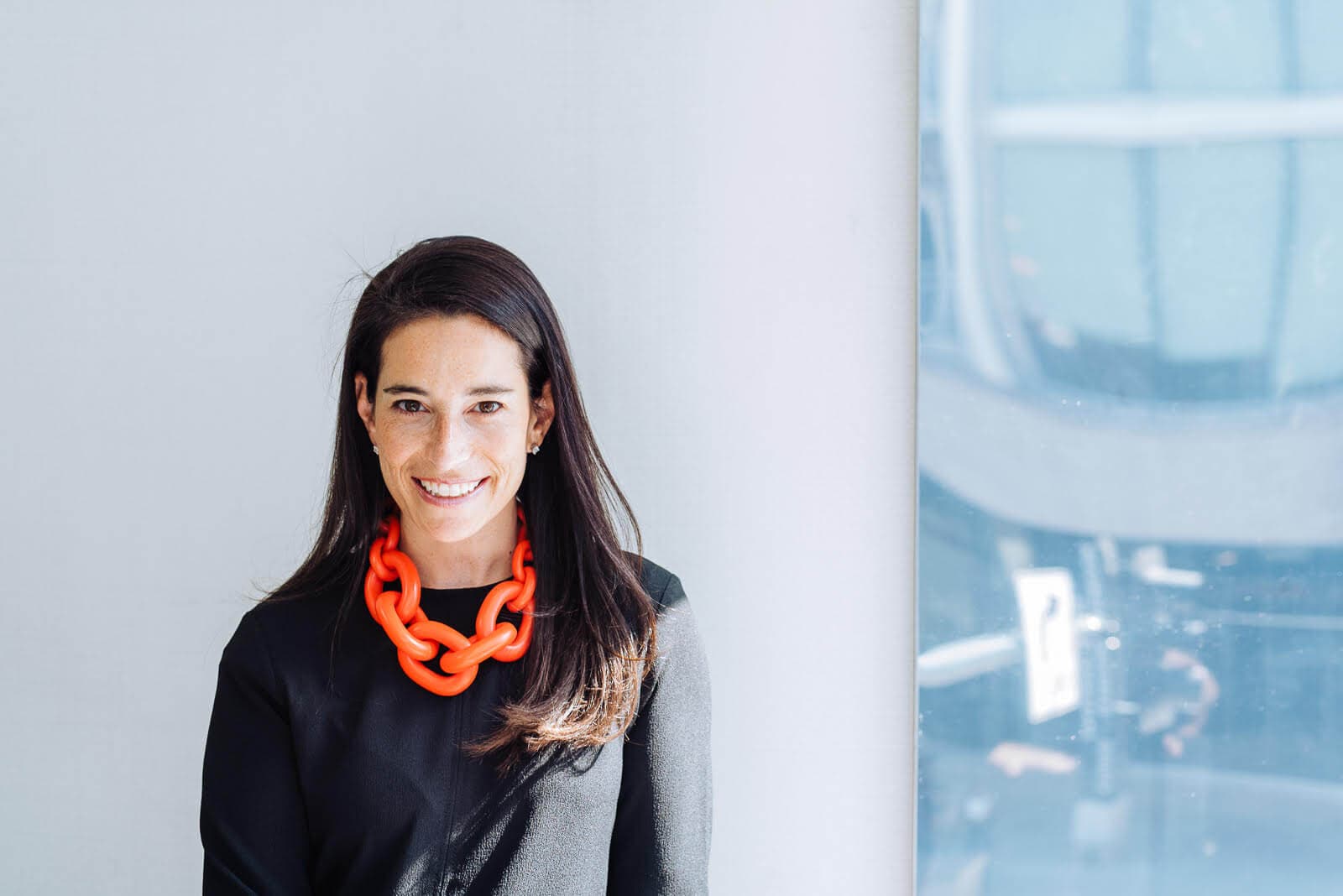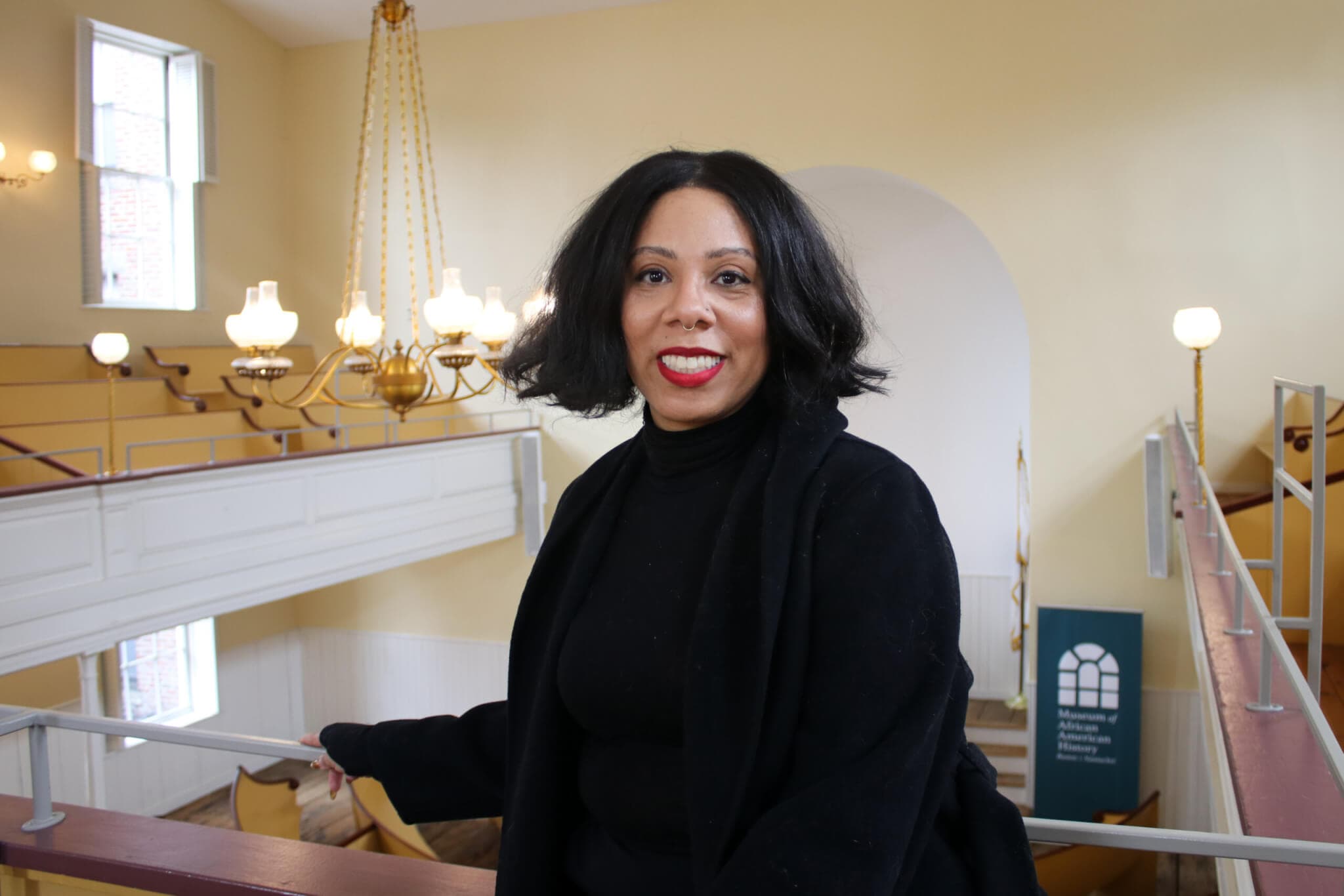Issue 14 • Oct 28, 2025
New to Town: Sarah Ganz Blythe, Nora Burnett Abrams, and Angela Tate
Now online from Issue 14: Half Full (originally published May 2025), Sarah Ganz Blythe, Nora Burnett Abrams, and Angela Tate discuss their first year on the job at Boston-area museums.
Feature by Jameson Johnson
Sarah Ganz Blythe, Nora Burnett Abrams, Angela Tate, 2025.

Sarah Ganz Blythe, Nora Burnett Abrams, Angela Tate, 2025.

Sarah Ganz Blythe, 2025.
Sarah Ganz Blythe
Jameson Johnson: Sarah, you’ve been at Harvard Art Museums since August. What is something that has surprised you about the institution? Any unexpected discoveries?
Sarah Ganz Blythe: What has surprised me is actually the continued existence of something I knew from a long time ago. When I was a sophomore at Wellesley College, I thought I wanted to be an art conservator. I did an internship at the Metropolitan Museum, where I learned a technique that allows us to see the underdrawings of paintings. And so rather naively, I called up the conservation department here and said, “Hey, I’ve learned this skill and I understand you’re doing similar work.” And the immediate response was “Oh, would you like to come and assist us?” I was invited into this institution to work on this very specific mode of examination. It was a generosity of spirit and a commitment to rigorous inquiry that I have been delighted and surprised to see is still very much alive here. The other thing that I really appreciated while I was working here during my undergrad was being able to learn from people with such expertise who were also humans in the world. They were asking critical questions and tackling big issues over their morning coffees—continually learning from one another. I think that has stayed with me my whole life.
JJ: Prior to your new role, you spent fifteen years at RISD. So you’re certainly not unfamiliar with the ins and outs of a large museum housed within a university. What excites you most about operating within the university context? What are the challenges?
SGB: What I find exciting about academic museums is that learning is always first and center. And at RISD it was very much centered on educating artists. What excites me about being in an ecosystem as large as Harvard is the way there is a constant cross-disciplinary investigation, which is really generative. I often think about how our main commitment is to educating the next generation. So as we do our work, there’s a certain level of humility—we’re learning by doing.
JJ: And the challenges?
SGB: If a museum wants to be relevant and participatory, then its challenges are part and parcel of the communities and spheres in which it operates.
JJ: What is something that you have seen shifting in art museums over the past few years that you think is an exciting or positive shift in the museum field?
SGB: I think the willingness to be self-reflexive and deeply interrogate the systems by which we were created in a way that does not have to deliver a new verdict of correcting the past, but rather acknowledges the ways in which museums have been exclusive and have written histories that are not embracing. I have been reflecting on the proposal made by Jules Prown that the work of art is a historical event that continues to act in our present, and we have the opportunity to encounter that primary source and learn from it. A perfect example of that is a program that we’ve just started called Gray Area, and it deliberately explores how works of art reflect the complexity of humanity and the impact of power dynamics, and offer opportunities for open inquiry. These Gray Area events are open to the public and focus on just one object. We present evidence and talk about the work without any pretense to deliver a verdict on its meaning or tie things up in a nice bow. This models what it means to look closely, think deeply, and begin to talk to one another, to simply have conversations.
JJ: What is something that you wish everyone knew about Harvard Art Museums?
SGB: I wish everyone knew just how much the collection is moving. We have over fifty galleries where the collection is on display. We also have our conservation labs and publicly accessible study rooms. About 40,000 objects per year are circulated through those spaces for teaching, for examination, and for consideration. That fluidity of objects being active is something that I find very exciting and antithetical to what we usually think museums are about—locked-in narratives that you basically sort of walk and view.
JJ: What are you reading right now?
SGB: There are two books I’m really excited about. One is a collection of Philip Guston’s writings called I Paint What I Want to See, and I am excited about that because he writes about his passion for Piero della Francesca. I started reading it because I was interested in thinking about what artists tell us about how they look at art and how they return again and again, perhaps to the same painting or the same artist, and draw inspiration, draw lessons from them, which is what we’re sort of set up to do—constantly return and reengage with the material-level work of art. I’m also reading the new book out from MoMA, Inventing the Modern: Untold Stories of the Women Who Shaped the Museum of Modern Art, which is a wonderful series of essays written about the founding of MoMA and the development of its collection. I love institutional histories and that’s just a wonderful one. And there’s a lot of intersection between that history and the history of the Harvard Art Museums.
JJ: In keeping with the theme for Issue 14: Half Full, what is something you feel optimistic about and what is something that you feel nervous about?
SGB: I’ll start with what I’m nervous about: I’m concerned about how cultural institutions will be sustaining themselves in a myriad of ways in the years ahead, both in terms of our programs and our finances. But I’m really optimistic about what I’m seeing in our galleries ever since we made the museums free to all. It’s been a little over a year and a half now, and our audience has more than doubled. And the liveliness and energy of these spaces is something that I’m very excited about. I love walking through the galleries and seeing tourists, classes, and families all in one place.

Nora Burnett Abrams, 2025.
Nora Burnett Abrams
Ellen Matilda Poss Director
of the Institute of Contemporary Art / Boston
Jameson Johnson: You are in the midst of departing from MCA Denver, an organization you’ve worked at since 2009, starting out as an adjunct curator. Is there a particular moment from your tenure that you are proud of?
Nora Burnett Abrams: There are so many, so this is going to be a little difficult. One that I’m extremely proud of is the day that we reopened on July 1, 2020, after the incredible lift of installing a new exhibition, “Nari Ward: We the People.” We couldn’t have the artist present and were also getting all of our health and safety accommodations in place. We were able to reopen fairly quickly—a testament to the creativity and flexibility that’s inherent in the DNA of the museum.
JJ: What is something that you’ve learned during your time at MCA that you feel like you’re bringing with you to Boston?
NBA: What a thoughtful question. I always try to think about the creative thought processes that I value so much from the artists I’ve worked with. This is probably something I learned more while being a curator, but I will certainly bring it with me as I enter this new role. How [can I] take a kind of flexible thinking toward the myriad of challenges and opportunities that greet us every day as leaders of an organization? This kind of creative thinking allows you to take in and hold together things that may seem very opposite, and yet acknowledge that both are valid and present and need to be attended to.
From the administration side of things, I have learned how to lead an organization that has a lot of staff members who are of different generations. Holding space to listen to all different perspectives and points of view has helped me maintain an open mindset.
JJ: You’ll be joining the ICA following in Jill Medvedow’s footsteps. How will you approach getting to know the institution?
NBA: I feel very, very fortunate to be coming into an institution that has been steered so beautifully by Jill, and that she is leaving at a moment where I know she feels so proud of what she’s built. The organization has been strengthened by the team, the board, the community—the ICA knows who it is and what it does because [Jill] brought so many partners along.
Institutions are really made up of the people that work there, that visit there, that value it from a range of different perspectives. So I think the primary thing that I’m going to do is to get to know the people. I want to do a lot of listening with staff, community partners, artists, and supporters. Like MCA Denver, it’s the people who make the ICA great, and so those are the people I want to learn from.
JJ: Have you learned anything surprising or unexpected through your interview process? Is there something you’re excited to dig into within your first year?
NBA: Well, I don’t know if this is surprising, but I’m really curious to learn more about the museum’s archives. The history of the exhibition program alone is so astounding and so meaningful in terms of the course of history of contemporary art. So wrapping my head around that is something I’m really eager to do. I suppose I didn’t come into the interview process thinking about the archives, but now it’s something I’m excited to spend time with.
JJ: I’m constantly surprised to see references to ICA exhibitions from the ’90s or early 2000s crop up in unexpected places. It’s definitely a rich history.
NBA: Definitely. Also, the staff and people that have been involved with the institution over the past several decades both from the curatorial side, but also on the administration and programming side. I’ve had people tell me “I worked there in the eighties” that I had just had no idea about.
JJ: What excites you most about Boston’s art scene?
NBA: I think being part of a community of colleagues who are doing such fabulous work in different ways and in different spaces and in different parts of the field. There are so many different types of spaces, from non-collecting museums to university museums to nonprofit art spaces. There’s depth in terms of how many museums are focuse on contemporary art. I think being a part of the dialogue and the discourse in a really vibrant and deeply thoughtful community is something I’m really looking forward to.
JJ: Those are many of the same reasons why I love Boston’s art community—it really is a community. Boston itself can sometimes feel unwelcoming, but I think our arts scene is always eager to welcome new people.
NBA: Yes, that already seems to be the case.
JJ: It’s been a tumultuous few months for arts and culture at the federal level. What do you see the role of museums and cultural spaces being in the next few years?
NBA: I don’t see anything shifting radically. I think that the mission, and the values that drive that mission, will be ever more elevated in importance because there’s going to be a lot of challenges and a lot of testing. As a director, the values of the institution have to be your North Star—they guide everything that you do. The pandemic taught us that museums, in many ways, are bigger than our buildings. Museums have to have a spirit of trust and partnership. As we anticipate more challenges, being clear about who we are and how we show up in the world will be our bulwark in the face of ongoing challenges.
JJ: Staying focused is always great advice. What are you reading right now?
NBA: Oh, I’m reading a novel by Juli Min called Shanghailanders. It’s a novel that starts several years into the future, and then each chapter rewinds a year. And so you’re kind of knitting together different narratives along the way, but in reverse.
JJ: I know it’s going to be a busy year for you with a cross-country move. What is something that you wish you had more time for?
NBA: Definitely gardening. I grew up in New York City in an apartment where we didn’t even have fake plants—no engagement with the natural world. Since living in Denver—which, let me be clear, is not the easiest place to grow things because it’s so dry—I have been spending time in the late spring and the summer trying to figure out how to do this. I love it so much, and I could spend a lot more time understanding the processes and understanding these tiny little tweaks that can radically shift and change what you’re growing.
JJ: Well, you’ll have plenty of water in New England, just a very short window to actually grow things! I’m a fellow gardener, but I grew up in Southern California, where my mom kept a community garden plot active all year long. The season always flies by here.
NBA: And I am still completely tickled every time that first thing peeks out; it gets me every time.
JJ: Same here. So the theme for this issue is Half Full. I’ve been asking everyone, what is something you feel nervous about and something you feel optimistic about?
NBA: I am feeling a little bit anxious about what is going to happen to some of the services that are provided to those who would otherwise not be able to access, let’s just say, healthy food or art in schools, and how those who would greatly benefit from such programs are highly at risk of losing those services. And so I’m thinking through ways other institutions might be able to fill that void. I’m still exploring what it all might mean, but trying to anticipate so that if something like that does happen, there’s an opportunity to respond quickly to fill that void.
On a personal note, I’m grateful that my family is very excited for this new adventure we’re about to go on. We’ve had a beautiful life here in Denver, and we were not necessarily looking to upend it, but we are very excited about the adventure of living in a totally different environment. Denver is known for its access to nature, but as an urban environment, it’s quite new. We’re excited to be in a place steeped in history, where its years are very present.

Angela Tate, 2025.
Angela Tate
Chief Curator and Director of Collections
at the Museum of African American History
Jameson Johnson: Prior to your role here at the Museum of African American History, you were the curator of women’s history at the Smithsonian’s National Museum of African American History and Culture. Is there a moment from your time there that you’re particularly proud of or something that still sticks with you in this new chapter?
Angela Tate: I curated my first exhibition at the Smithsonian, “Forces for Change: Mary McLeod Bethune and Black Women’s Activism,” which is now a perma nent exhibition in a gallery dedicated to the National Council of Negro Women and Mary McLeod Bethune. I still pinch myself. I was like, “Who gets a permanent exhibition at the Smithsonian?” I feel very lucky.
JJ: What an incredible legacy! You’ve been in Boston now since September 2024. This is a big moment for the museum as you are the first curator and director of collections to work with materials from a rich history of African Americans in Boston, Nantucket, and across wider New England from the eighteenth and nineteenth centuries. What does this role mean for the future of the museum?
AT: This is a moment for the museum to really think critically about the lens that it operates through. We’ve just celebrated the 200th anniversary of the African Meeting House on Nantucket. Next year will be the 220thanniversary of the Boston African Meeting House. This is not only the largest Black history museum in the region; it’s also housed in buildings built by the community. We’re thinking about how we can reflect what Boston is through the lens of Black history.
Personally, I’m also working on finishing my PhD. It’s a real trial by fire, but I’m able to bring both a scholarly and curatorial perspective to this work.
JJ: Can you tell us a little bit about the collection here or some objects or artifacts that are exciting to you?
AT: We have three to four thousand objects in our collection that include archeological materials, papers, and books. Our buildings are also considered to be part of the collection. We also have a fine art collection that I’m particularly excited to dig into. Our founder, Sue Bailey Thurman—and previous leadership like Byron Rushing, Ruth Batson, and others—was very close with a lot of artists, like Meta Warrick Fuller, Elizabeth Catlett, Allan Rohan Crite, and so many others. And so when I was looking through her archives, I saw so many early exhibitions mentioning artworks that we still have in the collection.
The Boston Athenaeum and the Isabella Stewart Gardner Museum have actually recently borrowed pieces from MAAH’s collection for an upcoming exhibition focused on the art and legacy of Allan Rohan Crite. Crite is often called the “Dean of African American Artists in New England,” and these exhibitions (and other events) seek to cement Crite’s place as a key figure in American cultural life.
JJ: What is something that you wish everyone knew about the museum?
AT: Well, I wish more people knew it existed, because I personally didn’t know it existed until I was recruited for the position. I’m really excited to share the history of these buildings. Again, these are two sites built by the Black community during the early 1800s that are still standing in the twenty-first century and are now in use as they were intended to be used. So many historic structures related to Black history are not as well preserved as these sites. Many people don’t know that this entire neighborhood, Beacon Hill, was a Black neighborhood.
JJ: And some of that is illustrated through the Black Heritage Trail, which the museum also oversees, correct?
AT: The Black Heritage Trail was actually created by Sue Bailey Thurman and her daughter. The copyright belongs to us, but it’s preserved through our partnership with the National Park Service. So many movements happened here—abolition, women’s rights, suffrage, anti-slavery.
JJ: Which locations were particular hubs for these movements?
AT: This is why it’s so important to also include Nantucket, because there was an abolitionist circuit where abolitionists—Black, white, newly freed, escaped enslaved people—were essentially going to these different sites like an Underground Railroad before people officially called it an Underground Railroad. There was a lot of movement between Nantucket and Boston and between these meeting houses. Frederick Douglass would speak here in Boston and then speak in Nantucket.
JJ: What do you see as the role of museums such as this one in the midst of our new presidential administration?
AT: That’s such an amazing question. I will point out that this museum has endured. Black history museums have endured through several different kinds of administrations. I mean, we can point to the founder of Black History Month, Carter G. Woodson, and how even under Jim Crow and all of its oppressions they knew that education was so important. And so even though it looks like the sky is falling, we’re holding the line because essentially we are saying Black history is American history and this is a history that belongs to everyone.
Regardless of what’s being pushed down from the national or federal level, we have a strong network of history lovers locally. I think everybody should really focus on what’s in our own backyards, what we can share, and what we can protect.
JJ: What are you reading right now?
AT: Oh gosh. I never thought I would be excited about whaling, but like I said, Nantucket is such a vital part of the museum’s history, despite it being an island. But one of my grad school friends teaches at the American University in Paris, and she told me that when she was in Namibia doing research, she was studying Southern African history and people were talking about Nantucket and Nantucket whaling. I’m reading a few books about Black whalers and thinking about how the sea is a site of so much complexity because Absalom Boston, who was from the family who owned the Boston-Higginbotham House on Nantucket, was a Black whaler who had his own ship. Many Black whaling captains had interracial crews. So in a time of slavery in the United States, there are Black men leading ships with white sailors.
JJ: Wow! I had no idea about that history. The theme for Issue 14 is Half Full. What is something that you feel nervous or worried about, and what is something that you feel optimistic about?
AT: I’m always nervous and worried about my capacity, because I have big ideas, big thoughts, things that I would love to execute. I love collaboration and convening. But there are only so many hours in the day. Whatever power my brain runs on depletes very quickly right now, because I’m doing a lot. But that’s time and capacity.
JJ: And something you’re optimistic about?
AT: As we go into the semiquincentennial of the revolution in 2026, being able to point to this museum as one of the many places that are telling a more complex and complicated history of America’s founding.
JJ: What will the museum present?
AT: We have an exhibition called Black Voices of the Revolution opening on Juneteenth. It looks at the Black experience through the lens of loyalists, patriots, women, enslaved people, free people, and how they conceived of themselves during this tumultuous time—roughly the 1780s to the 1810s.
JJ: What do you hope visitors will take away from that exhibition?
AT: At this stage in the exhibition planning, we’re using these digitally immersive technologies to tell stories that people often would not hear directly from people. So as you see with our AI Frederick Douglass (which is currently on view), he has a wide and robust data set to pull from. The people that I’m thinking about in this early period did not leave extensive written records of their lives. We are using the primary resource documents that we do have to kind of extrapolate from there. I’m pulling from Saidiya Hartman’s Venus in Two Acts to think about what we do with fragments in the archive.
